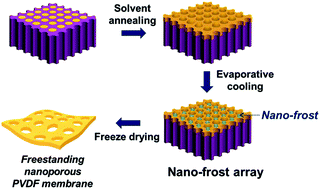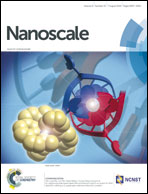A nano-frost array technique to prepare nanoporous PVDF membranes†
Abstract
Frost, the solid deposition of water vapor from humid air, forms on the surface of a solid substrate when its temperature drops below the freezing point of water. In this study, we demonstrate how this natural phenomenon can be applied to develop novel nanoporous materials. The solvent annealing of polyvinylidene fluoride (PVDF) infiltrated into nanopores induced template-directed dewetting thus preparing nanoembossing films. Then, water nanodroplets formed on the cold polymer nanopatterned surfaces following the embossing patterns, similar to dew formation on the ground. Subsequently, the nanodroplets were frozen and then removed by freeze-drying. This nano-frost array technique produced nanoporous PVDF membranes with an average thickness of 250 (±48) nm. It was revealed that the nanopatterned surface formed by solvent annealing played an important role in achieving a nano-frost array with an adjustable size. Additionally, the freezing process led to significant changes of the PVDF crystallinity and polymorphism. Our results prove that the nano-frost array technique can be broadly used to design ordered nanoporous structures and provide new prospects in nanomaterial fields.


 Please wait while we load your content...
Please wait while we load your content...